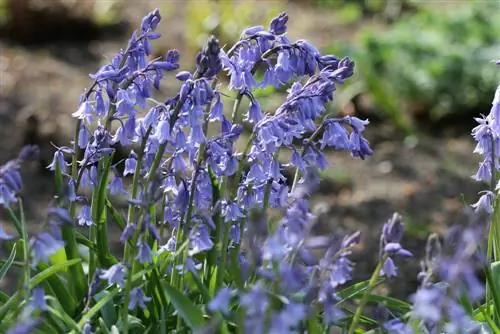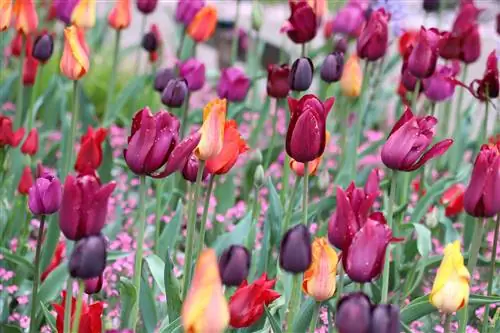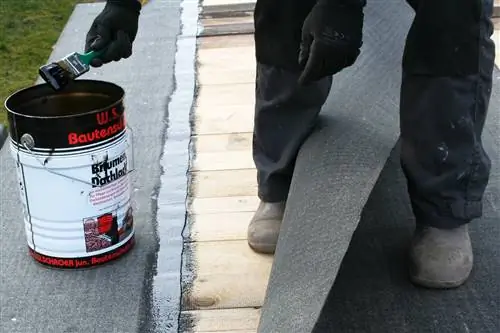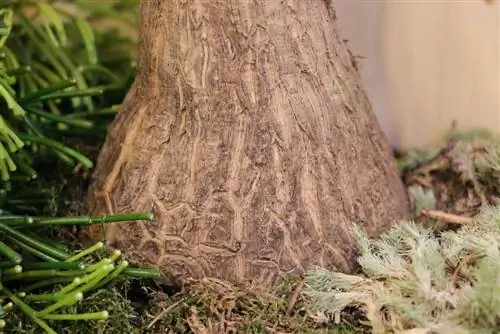- Author admin [email protected].
- Public 2023-12-17 03:39.
- Last modified 2025-01-24 12:45.
When the enchanting bell ringers unfold their concentrated flowers, the most wonderful time of the year has begun. Spanish hare bells are excellent at filling previously barren garden corners with vibrant life. With a growth height of up to 40 centimeters, it towers over the majority of other early bloomers with its nodding white, blue or pink bell flowers. In order for a Hyacinthoides hispanica to set its decorative accents for many years, it only requires a little care. The following lines explain in detail what hobby gardeners should pay attention to.
Profile
- Plant genus hare bells (Hyacinthoides)
- Species: Spanish Harebell (Hyacinthoides hispanica)
- Native to the forests of Spain and Portugal
- Hardy bulb flower
- Growth height 30 to 40 centimeters
- White, blue or pink bell flowers without fragrance
- Raceous inflorescences above lanceolate, green leaves
- Flowering period from April to May
- Other name: Bell squill
The close botanical relationship with squill and grape hyacinths is obvious. Nevertheless, rabbit bells rightly represent an independent genus.
Care tips
A well-established Spanish harebell is easy to care for. When the growing season begins in spring, maintaining a balanced water and nutrient balance is limited to the following aspects:
- Water the flowers regularly when it is dry
- The surface of the earth should dry in the meantime
- In parallel with the beginning of budding, fertilize with compost and horn shavings or mineral fertilizer
- Two additional doses of fertilizer are recommended, immediately after flowering and in autumn
- Clean out wilted flowers regularly to attract more bells
After flowering, give the bulb enough time in the soil to absorb all remaining nutrients from the plant parts. This process forms the basis for renewed growth next year. The foliage should be completely dry when cut off. The withered inflorescences, on the other hand, should be cut off early so that the plant does not invest energy in the development of seed heads. However, if propagation by sowing is desired, a Spanish harebell is of course not beheaded.
Tip:
Mulching the bed with flower bulbs with peat, pine bark or leaves before the first frost provides careful winter protection. At the same time, premature warming of the soil in spring is prevented.
Propagate
If the Hyacinthoides hispanica is given the obligatory care, it reproduces at a rapid pace on its own. You might want to use such growth power in other locations in your green kingdom, so that the different methods of propagation now come into focus.
Daughter onions
Once a Spanish harebell has faded, this is the ideal time for propagation using daughter bulbs. As the name suggests, the flower bulb develops several bulbs over the course of the growing season, which are clearly visible on the sides. These are buds that develop into breeding bulbs within the leaf axils of the onion skins. They are designed in such a way that they are responsible for the continued existence of the flower after the mother bulb dies. These daughter bulbs are ideal for breeding because they are already self-sufficient. This is how the method works:
- After flowering, dig up the flower bulb with as much soil as possible
- Cut off the daughter bulbs with a sharp, disinfected knife
- At least one bulb should remain attached to the mother bulb
The onions obtained in this way are stored in a dry, cool and dark place until autumn. Under no circumstances should they be exposed to intense light so that they do not sprout prematurely.
Sowing
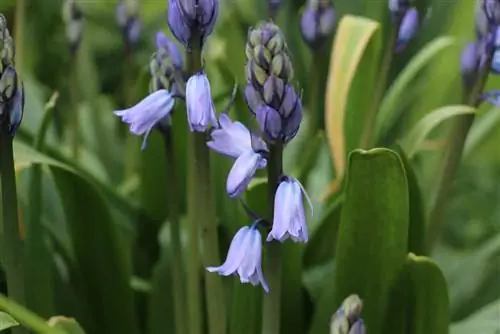
If you let your blue squills do their thing in the bed, they will produce countless capsule fruits. Shortly before they burst open to release the seeds, they are collected and opened under controlled conditions to access the seeds. This is how you sow correctly:
- Soak the black, spherical seeds in water at room temperature for 4-6 hours
- Fill cultivation pots with peat sand, coconut fiber, perlite or seed soil from the market
- Spread the seeds on top and sieve thinly with substrate or sand
- Moisten with water from the spray bottle
- Alternatively, place the pots in a few centimeters of water to water them from below
- Cover seed containers with cling film or place in the indoor greenhouse
- Expect germination in a partially shaded window seat at 23-26 degrees Celsius
Until the cotyledons appear, check the moisture content of the seed regularly so that it does not dry out. After germination, the cover can be removed so that the young leaves do not hit it. The young plants are pricked from the second or third pair of true leaves.
Tip:
Specific propagation using self-collected seeds is tricky because it can only be achieved with seeds of the purest variety. In this case, it is recommended to purchase certified seeds from specialist retailers.
Plants
From the end of September to the end of October, the time window is open for planting bluebell squills. The bulb flowers reach their optimum in a semi-shady to shady location. The soil should be humus and well-drained. Ideally, the pH value is slightly acidic to neutral. How to use a Spanish hare bell correctly:
- Loosen the soil thoroughly and weed thoroughly
- If necessary, enrich the soil with compost or sand
- Dig small planting holes, with a depth of 8-10 centimeters
- Place the flower bulbs 10 centimeters apart
- Preferably arrange in small tuffs
- Cover with soil, press down and water carefully
Are you aiming to create one of those wild flower carpets that look impressive under tall trees? Then with Hyacinthoides hispanica you have an ideal candidate in your hand. A particularly natural appearance is created by combining various early bloomers, such as snowdrops, crocuses, squills, daffodils and all three colors of the Spanish haredrop.
Effective protection against voles
The greatest danger to bulb flowers comes from insatiable voles. Save the spring flower from ending up in the stomachs of hungry rodents by planting each tuff in a wire basket. These are made of wire mesh with a mesh size of 12-13 millimeters and shaped into a square. The top of the basket remains open because voles avoid the surface of the soil. Place the vole basket in a 12 centimeter deep hole. The ground is covered with a 2-3 centimeter high layer of sand to protect against waterlogging. Fill the potting soil here and insert the flower bulbs.
Conclusion
In spring, the Spanish harebell covers partially shaded and shady areas of the garden with a sea of flowers in blue, white and pink. From May onwards, the grape-shaped bell flowers herald the most wonderful time of the year without requiring any time-consuming care. The key points are regular watering and applying fertilizer three times. In addition, care must be taken not to prune until the Hyacinthoides hispanica has completely wilted. Propagation is just as uncomplicated, although it is particularly easy to do with breeding onions.

